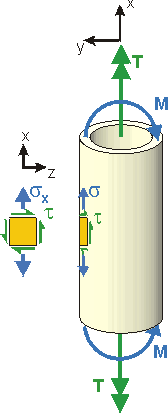Background: The shaft of a femur (thigh bone) can be approximated as a hollow cylinder. The significant loads that it carries are torques and bending moments.
Given: The femur shaft has an outside diameter of 24 mm and an inside diameter of 16 mm. The tensile strength of bone is taken to be Su = 120 MPa.
During strenuous activity, the femur is subjected to a torque of 100 N·m.
Req'd: The effective moment the bone can take without failure. Consider only torsion and bending loads, and take the bone to be a brittle material.

Image: eSkeletons Project








